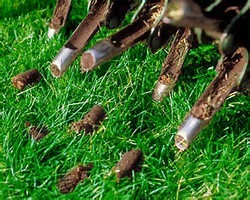Core Aeration and Overseeding
Core Aeration
What it is- Core aeration is the removal of small cores of soil to allow air, moisture, and fertilizer down to the root zone. An aerator will pull one to two inch plugs of soil from the ground. These plugs are deposited on the soil's surface where they will break down. Soil surrounding the plugged holes and the soil deposited on top will collapse and fill in the holes.
Why is it necessary- It is estimated that nearly 70% of residential lawns are growing on compacted soils. Many times there is no evidence of insect or disease activity, yet the lawn seems to be off-color, thinning, and shows signs of stress in high temperatures. Compaction is a physical process where the soil gets more compressed so that there is a reduction of the amount of oxygen contained in the soil and movement of nutrients to the roots of the grass. The roots need oxygen and as they grow they give off carbon dioxide. Eventually the lawn thins until, ultimately, the soil can no longer support any turf growth.
How it works- The controlled removal of the small soil cores has many benefits. It allows fertilizer, water, and air to quickly reach the root zone of your grass. Core aeration creates healthy roots and thicker, more beautiful lawns. Core aeration is the best kept secret to a great lawn!
Overseeding
Overseeding a lawn can help improve its overall appearance and more importantly its health. Lawn overseeding is the process of spreading grass seed over an existing turf. Lawns that suffer from insect or disease damage, drought stress, or bare patches benefit tremendously from overseeding. Overseeding a lawn is the best way to thicken the lawn and improve its appearance. The new turfgrass is able to resist damage from drought, disease, and lawn damaging insects. By itself lawn overseeding can be effective but it is often combined with lawn aeration. The holes created by the aeration allow good seed to soil contact, this adds to the seed germination.
Benefits of overseeding a lawn include: filling in areas of turf damaged by summer stress, diseases, or insects. Thickening and increasing the density of the lawn. Improving the lawns appearance and enhancing the lawns ability to fight insects and diseases.
We use the following seed mixture when overseeding: Kentucky Bluegrass, Perennial Rye, and Fine Fescue
*For best results lawn should be watered regularly after seeding occurs
